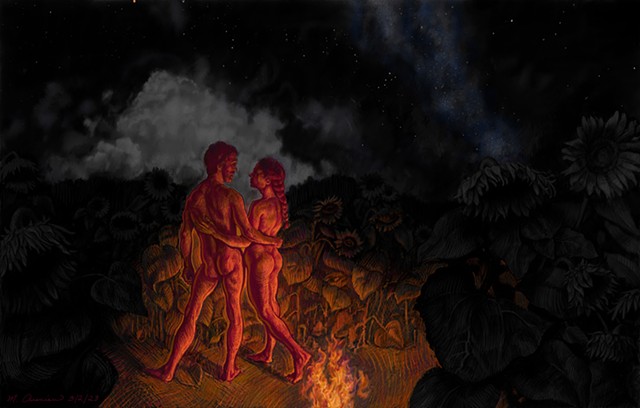Digital Paintings
* To enlarge, click over the image's upper right corner *
* For commentary about this painting, scroll down *
"Sunflowers in Moonlight," "Hemera," "In These Metal Days," "Ether," "Foam," "Form," and "Format" depict the primeval forces of the ancient Greek religion. Out of nothingness, the four primeval elements sprung: Chaos, Gaia (Mother Earth), Tartaros (The Underworld), and Eros (Love, Sex). The ancient Greeks don't even try to explain how these fundamental cosmic forces came to be; they just appeared.
Since I'm exploring the personifications of primordial forces and entities, I thought my characters should be unclothed. I didn't want to depict my Greek gods wearing togas and flowing robes. The ancient Greeks might have worn such clothes, but I wonder if their overuse by artists since trivializes and diminishes the Greeks' far-reaching ideas about cosmic creation. I think such garb just reinforces the idea that they belong only to the past. I didn't want to dress them in modern attire either because this, too, would date them. I think nudity takes them out of time and makes them ever present, eternal.
I read in the annotations of "The Homeric Hymns" and Hesiod's "Theogony," that ancient Greeks believed that something could come from nothing. For them, a force that appears to have no substance, such as thunder, through its mere collision and friction against more thunder, produces a new and unrelated force, lightning. Lightning strikes or "collides" with the ground to produce fire. Here's another example, the striking of flint and steel: two unrelated substances, produce a third unrelated substance, sparks and fire. I think this explains why the Greek gods had so many sexual unions--"frictions." Their sexual encounters are not merely about the birth and formation of the Greek pantheon of gods: they are metaphors for cosmic creation: "friction" alone can produce new substances and new forces. "Friction" explains how everything came to be.
Immediately following their birth, only the primeval forces Chaos and Gaia had children. They didn't have sex to have their children; Chaos and Gaia immaculately conceived their progeny--something from nothing, no friction even! "Sunflowers in Moonlight" depicts Chaos's kids and a few of their offspring: Erebos (Male/Darkness) and Nyx (Female/Night). Brother and sister, Erebos and Nyx, had sex and produced Hemera (Female/Day) and Ether (No gender or human form/The Heavens, Space, the Cosmos).
The night scene in Adam Elsheimer’s painting “Flight into Egypt” was my strongest inspiration and influence for “Sunflowers in Moonlight.” His painting was my guiding light for my own. Like Elsheimer, my night sky is naturalistic and depicts it as it would appear, Milky Way included! Looking North on a summer night in Greensboro—minus the light pollution.
Under the moonlit sky in a field of sunflowers amid sparks, fire, thunder clouds, and the Milky Way, Darkness and Night embrace while the stars compose their lucid song.
